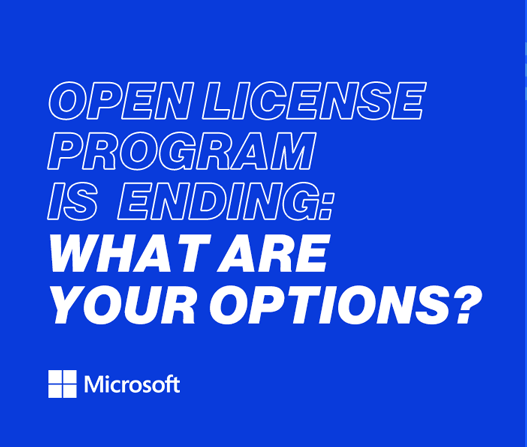Microsoft licensing changes – the end of the Open License Program

More Changes
In preparing for this version of my blog, I went back and read the April 2020 version in which I talked about Microsoft introducing or renaming their Microsoft 365 product line. I started off that blog making light of the “Bizzaro World” I lived in at the time. The Covid-19 Pandemic was just in full swing with the 30 days to stop the spread shutdown in full effect. All our lives have been fundamentally changed as we navigate through the daily effects the Pandemic continues to bring, truly a “Bizzaro World”.
Also, in that blog, I discussed how Microsoft is pushing its customers to the cloud by making some features in their cloud version of software not available in the on-premises version of software.
Microsoft states in their Office 2019 for Windows FAQ…
“Office 2019 (for both Windows and Mac) is a one-time purchase and does not receive feature updates after you purchase it. It includes a meaningful subset of features that are found in Microsoft 365, but it’s not part of Microsoft 365. Office 2019 will receive quality and security updates as required.”
Microsoft Open Programs
In September 2020, Microsoft announced they would be ending the Open License program at the end of 2021. For those that might not be familiar with the Open Programs, there are three:
-
- Open Value – recommended if you have a small to midsize organization with five or more desktop PCs and want to simplify licensing management, manage software costs, and get better control over your software investments. It also includes Software Assurance (SA), providing valuable benefits such as training, deployment planning, software upgrades, and product support. At the end of the agreement, you could renew your agreement for another 3-year term, purchasing only SA to continue accessing the latest product versions and other benefits. Or you can let the agreement expire and own the rights to the current version at the end of your agreement term, but you will no longer continue receiving SA benefits or upgrade rights.
- Open Value Subscription – provides the lowest up-front costs. It also includes SA mentioned above. It is a 3-year agreement which takes the purchase and spreads the payments over three annual payments. At the end of the term, you have three options:
- Renew your agreement for another three-year term and continue enjoying the latest licensed products and other benefits, or
- Make an optional buyout payment to own the licenses for the current version at the end of your agreement, or
- Choose to not renew your agreement and forfeit the rights to use the products.
- Open License – is very much the same as the Open Value, but SA is optional purchase. Open License is commonly used for purchasing as-needed software licenses and online services. If SA was not purchased, the software license is only good for the current version of software. There are no upgrades included without SA.
Open License moving to Cloud Solution Provider (CSP)
“Simplifying the purchase experience for our customers is a core element of making it easier to do business with Microsoft. It requires a change in the way we’ve engaged with you, and in how you buy and manage your software licenses and subscriptions for online services.”
“In September 2020, we announced changes to the Microsoft Open License program with the introduction of perpetual software license purchases through the new commerce experience. If you’re a small or midsized customer, you can now buy software licenses from partners participating in the Cloud Solution Provider program. As a result, we’ll be ending purchases through the Open License program on December 31, 2021. If you have a small or midsize organization with little or no IT resources, Microsoft partners can provide expertise and services and build unique solutions with the latest Microsoft services and offers.”
Previously, Open License purchases were made through CSP Partners, such as Zunesis. The CSP model was designed for the partner to add value to its customers’ cloud experience via support, billing flexibility and advice. The customer effectively has a pay as you go consumption arrangement through the partner, rather than directly with Microsoft.
CSP has numerous benefits to customers. One is Flexibility. This is where you pay for what you use and have the ability to add/remove licenses on a monthly basis. Other features include Monthly Billing, no upfront costs, benefit from the Partner’s Licensing expertise, and discounts off MSRP to name a few.
Seriously, what does this mean?
It means these as-needed software purchases without SA will be subscription-based purchases through Microsoft’s Cloud.
Does this mean you have to “move” to the cloud?
No, you get all the features you are used to, with the flexibility of the CSP program. The software is downloaded and installed the same way it always was.
In fact, it could be argued that licensing through CSP has better benefits than SA.
Office Productivity Suite
There are several options for purchasing Office via CSP, some include online services, some are software only. Plans start as low as $5 per month. Each one of these plans include always up to date software. When updates are released, the user is prompted to install them. A few examples:
- Microsoft 365 Business Apps ($8.25/mo) – provides access to the Office Online Applications (through a web browser) and also download and install Office on the user’s PC. Includes 1 TB of storage in OneDrive.
- Microsoft 365 Business Basic ($5/mo) – provides access to the Office Online Applications (through a web browser). Includes 1 TB of storage in OneDrive and Exchange Online email with a 50 GB mailbox.
- Office 365 Apps ($12/mo) – provides access to the Office Online Applications (through a web browser) and also download and install Office on the user’s PC. Includes Teams. Includes 1 TB of storage in OneDrive.
Windows/SQL Server/BizTalk Server/Exchange Server
Windows Server and Microsoft SQL Server can be purchase through CSP. These licenses can be used both on-premises and in Azure, saving 40% in Azure using the Hybrid Benefit and save more as there is no need for Client Access Licenses in Azure. Customers are billed monthly for the CSP licenses, even though the server purchases are annual.
Conclusion
Microsoft continues to push customers toward their cloud offerings. There are a lot of combinations when looking at Microsoft Licensing through CSP. A CSP Partner can assist in finding the most cost-effective solution for your organization.
Categories
Search
Blog Categories
Related Resources
Archives
- July 2024
- June 2024
- May 2024
- April 2024
- March 2024
- January 2024
- October 2023
- September 2023
- August 2023
- July 2023
- June 2023
- May 2023
- April 2023
- March 2023
- February 2023
- January 2023
- October 2022
- July 2022
- June 2022
- May 2022
- April 2022
- March 2022
- February 2022
- January 2022
- December 2021
- November 2021
- October 2021
- September 2021
- August 2021
- July 2021
- June 2021
- May 2021
- April 2021
- March 2021
- February 2021
- January 2021
- December 2020
- November 2020
- October 2020
- September 2020
- August 2020
- July 2020
- June 2020
- May 2020
- April 2020
- March 2020
- February 2020
- January 2020
- December 2019
- November 2019
- October 2019
- September 2019
- August 2019
- July 2019
- June 2019
- May 2019
- April 2019
- March 2019
- February 2019
- January 2019
- December 2018
- November 2018
- October 2018
- September 2018
- August 2018
- July 2018
- June 2018
- May 2018
- April 2018
- March 2018
- February 2018
- January 2018
- December 2017
- November 2017
- October 2017
- September 2017
- August 2017
- July 2017
- June 2017
- May 2017
- April 2017
- March 2017
- February 2017
- January 2017
- December 2016
- November 2016
- October 2016
- September 2016
- August 2016
- July 2016
- June 2016
- May 2016
- March 2016
- February 2016
- January 2016
- December 2015
- October 2015
- September 2015
- August 2015
- July 2015
- June 2015
- May 2015
- April 2015
- March 2015
- February 2015
- January 2014
- February 2013




